Python GUI Programming With Tkinter
根据原网站内容做了一些增补
REF: Real python
- Several strengths:
- cross-platform: so the same code works on Windows, macOS, and Linux.
- Applications built with Tkinter look like they belong on the platform where they’re run: Visual elements are rendered using native operating system elements
Building Your First Python GUI Application With Tkinter
- Windows:
- The foundational element of a Tkinter GUI
- The containers in which all other GUI elements live.
- widgets: These other GUI elements: such as text boxes, labels, and buttons
- 导入模块:
import tkinter as tk - 添加一个窗口:A window is an instance of Tkinter’s
Tkclass. Go ahead and create a new window and assign it to the variablewindow:window = tk.Tk() - 添加一个小部件(widget):用tk.Label添加一些文字。
greeting = tk.Label(text="Hello, Tkinter")。- 这样并不会在窗口上添加文字,因为你仅仅创建了一个Label对象,它和window并没有实际的交集。
- 我们必须将Label添加到window上,我们有多种方法,以下为其中的一种:
greeting.pack()。 - 当您将小部件打包到窗口中时,Tkinter 将窗口调整得尽可能小,同时仍然完全包围小部件。
- 添加以下命令:
window.mainloop()。window.mainloop()告诉 Python 运行 Tkinter event loop(事件循环)。此方法侦听事件,例如按钮单击或按键,并阻止其后的任何代码运行,直到您关闭调用该方法的窗口为止。
参考代码:
import tkinter as tk
window = tk.Tk()
label = tk.Label(text="Python rocks!")
label.pack()
window.mainloop()
用小部件进行设计 Working With Widgets
- 小部件(widgets)是Python GUI框架的基石。每一种小部件都是由类定义的。以下是可供使用的一些小部件:
| Widget Class | Description |
|---|---|
Label |
A widget used to display text on the screen |
Button |
A button that can contain text and can perform an action when clicked |
Entry |
A text entry widget that allows only a single line of text |
Text |
A text entry widget that allows multiline text entry |
Frame |
A rectangular region used to group related widgets or provide padding between widgets |
Label部件:
- 用来显示文字或者图片
- 用户(user)无法编辑该部件的文字,该部件仅做显示使用
- 如果不指定,Label会以默认的颜色和背景进行显示。
label = tk.Label( text="Hello, Tkinter", foreground="white", # Set the text color to white background="black" # Set the background color to black ) - 可以通过设置进行调整,以下有多种颜色可以供选择:
"red""orange""yellow""green""blue""purple"- 【Note】:
- 大部分的HTML颜色名字,对Tkinker都是起作用的。
- colors manual page也可以供查阅
- 十六进制的颜色hexadecimal RGB values也可以用来表示颜色:
label = tk.Label(text="Hello, Tkinter", background="#34A2FE")
- 可以通过设置前景以及后景,宽度和高度调整Label:
- 因为Tkiner用的是字符单位(text units)。水平和宽度的单位都是数字0的测量值(所以你知道为什么10*10不是一个正方形了吧)。
- 通过字符宽度测量单位意味着小部件的大小是相对于用户计算机上的默认字体的。这可以确保文本正确地适合标签和按钮,无论应用程序在何处运行。
- 因为Tkiner用的是字符单位(text units)。水平和宽度的单位都是数字0的测量值(所以你知道为什么10*10不是一个正方形了吧)。
label = tk.Label(
text="Hello, Tkinter",
fg="white",
bg="black",
width=10,
height=10
)

Button
- 用来做成可点击的按钮。
- 可以配置成按下去后调用一个函数。
- Button和Label有很多的相似之处,某种意义上,Button就是一个可供点击的Label–> 也就是说Label的好多参数,Button同样可以使用。
button = tk.Button(
text="Click me!",
width=25,
height=5,
bg="blue",
fg="yellow",
)
效果图:
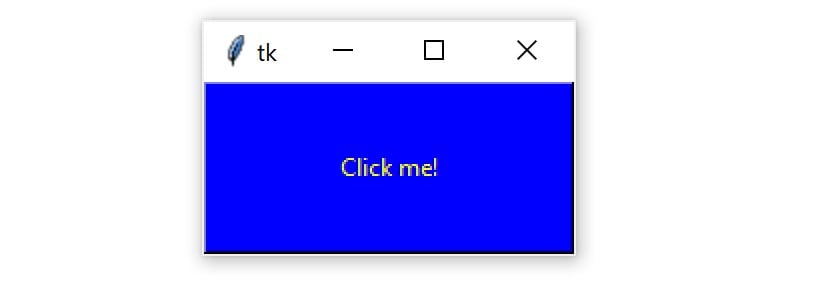
Entry
- 给用户提供输入,但是只能显示一行
- 最重要的是如何从用户处获得输入,主要有以下三种方式:
- Retrieving text with
.get() - Deleting text with
.delete() - Inserting text with
.insert()window = tk.Tk() label = tk.Label(text="Name") entry = tk.Entry() label.pack() entry.pack()
- Retrieving text with
仅仅是上面的代码,并不能获取用户的输入。因为用户的输入并没有发送给程序。可以通过以下方法获取:name = entry.get()
- delete方法和字符串分割的用法类似:
entry.delete(0):删除第一个字符entry.delete(0, 4):删除0-4这五个字符entry.delete(0, tk.END):删除所有字符串
- Insert方法是插入字符串:
entry.insert(0, "Python"):0表示插入位置
Text
- Text提供给用户进行输入,它可以提供多行输入
- 可以认为是扩展版的Entry
- 几个常用的方法:
- Retrieve text with
.get() - Delete text with
.delete() - Insert text with
.insert()
- Retrieve text with
- Text的使用方法与以上几个类似: ```Python window = tk.Tk()
text_box = tk.Text()
text_box.pack()
- get方法:需要至少一个参数。
- `text_box.get("1.0")`:一个参数的话,只返回一个字符
- `text_box.get("2.0", "2.5")`:
- 2.0:2表示第二行,0表示第一个字符开始
- 2.5: 2表示第二行,5表示第五个字符
- `text_box.get("1.0", tk.END)`: 什么意思显而易见
- delete方法用法与get类似,只是删除文字。但是删除后,该行变成了`\n`。我们可以用`text_box.delete("1.0")`删除这个新行字符。
- `text_box.delete("1.0")`
- `text_box.delete("1.0", "1.4")`
- `text_box.delete("1.0", tk.END)`: 清空文本框
- Insert方法:
- `.insert("<line>.<column>")`
- `text_box.insert("1.0", "Hello")`: 在首行插入字符
- `text_box.insert("2.0", "World")`:紧接着第一行尾部插入。如果第一行没有换行符,那么就是紧接着字符后插入。
- `text_box.insert("2.0", "\nWorld")`: 换行插入
- `text_box.insert(tk.END, "Put me at the end!")`: 在文本框末尾追加字符串。
There are several others, including widgets for checkboxes, radio buttons, scroll bars, and progress bars. For more information on all of the available widgets, see the Additional Widgets list in the [Additional Resources](https://realpython.com/python-gui-tkinter/#additional-resources) section.
### Frame
- Frame是用来组织页面上小部件(widgets)的布局的
- Frame是给其他部件提供容器的最好选择
```python
import tkinter as tk
window = tk.Tk()
frame = tk.Frame()
frame.pack()
window.mainloop()
可以通过制定部件的master属性,来将一个部件赋给frame。
frame = tk.Frame()
label = tk.Label(master=frame)
为了了解具体的工作情况,可以运行测试以下代码:
import tkinter as tk
window = tk.Tk()
frame_a = tk.Frame()
frame_b = tk.Frame()
label_a = tk.Label(master=frame_a, text="I'm in Frame A")
label_a.pack()
label_b = tk.Label(master=frame_b, text="I'm in Frame B")
label_b.pack()
#如果交换下面两行代码的顺序,Frame顺序也会变化
frame_a.pack()
frame_b.pack()
window.mainloop()
运行结果大概是下面这个样子:

Label,Button,Entry, 和Text在实例化后都有master属性。
Note: If you omit the master argument when creating a new widget instance, then it’ll be placed inside of the top-level window by default.
用Reliefs调整Frame的外观:
tk.FLAT: Has no border effect (the default value)tk.SUNKEN: Creates a sunken effecttk.RAISED: Creates a raised effecttk.GROOVE: Creates a grooved border effecttk.RIDGE: Creates a ridged effect
以下为五个不同效果的Frame:
import tkinter as tk
border_effects = {
"flat": tk.FLAT,
"sunken": tk.SUNKEN,
"raised": tk.RAISED,
"groove": tk.GROOVE,
"ridge": tk.RIDGE,
}
window = tk.Tk()
for relief_name, relief in border_effects.items():
frame = tk.Frame(master=window, relief=relief, borderwidth=5)
frame.pack(side=tk.LEFT)
label = tk.Label(master=frame, text=relief_name)
label.pack()
window.mainloop()

borderwidth: 表示宽度,单位为像素点,至少大于1
命名约定 Understanding Widget Naming Conventions
- 如果标签小部件用于显示用户名,那么您可以将该小部件命名为 label_user_name。用于收集用户年龄的 Entry 小部件可能称为entry_age。
- 有时候不需要给部件指定变量的时候,可以在其定义后面直接加上
.pack():tk.Label(text="Hello, Tkinter").pack() - 为了使命名的长度降低,可以使用以下缩写:
| Widget Class | Variable Name Prefix | Example |
|---|---|---|
Label |
lbl |
lbl_name |
Button |
btn |
btn_submit |
Entry |
ent |
ent_age |
Text |
txt |
txt_notes |
Frame |
frm |
frm_address |
布局的控制管理 Controlling Layout With Geometry Managers
- 一共有三种几何管理器(Geometry Managers):
.pack().place().grid()
- Each window or Frame in your application can use only one geometry manager. However, different frames can use different geometry managers, even if they’re assigned to a frame or window using another geometry manager.
.pack()
- 利用packing algorithm布置,有两个优先的步骤:
- 创建一个满足部件的矩形区域(宽度或者高度适合):Compute a rectangular area called a parcel that’s just tall (or wide) enough to hold the widget and fills the remaining width (or height) in the window with blank space.
- 部件优先居中:Center the widget in the parcel unless a different location is specified. ```python import tkinter as tk
window = tk.Tk()
frame1 = tk.Frame(master=window, width=100, height=100, bg=”red”) frame1.pack()
frame2 = tk.Frame(master=window, width=50, height=50, bg=”yellow”) frame2.pack()
frame3 = tk.Frame(master=window, width=25, height=25, bg=”blue”) frame3.pack()
window.mainloop()
效果如下:
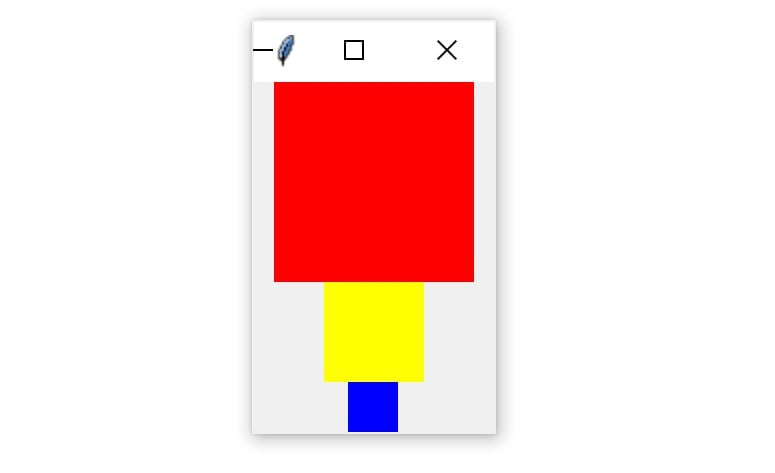
- pack()函数可以设置一个方向填满fill:
```python
import tkinter as tk
window = tk.Tk()
frame1 = tk.Frame(master=window, height=100, bg="red")
frame1.pack(fill=tk.X)
frame2 = tk.Frame(master=window, height=50, bg="yellow")
frame2.pack(fill=tk.X)
frame3 = tk.Frame(master=window, height=25, bg="blue")
frame3.pack(fill=tk.X)
window.mainloop()
效果如下:
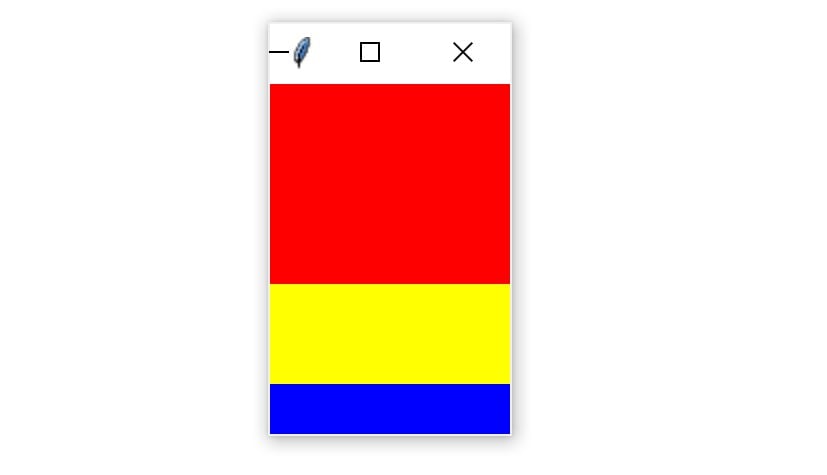
- side关键字指定了小部件应该放置顺序(从左往右?从上往下之类的):
tk.TOP:默认是从上往下tk.BOTTOMtk.LEFTtk.RIGHT
import tkinter as tk
window = tk.Tk()
frame1 = tk.Frame(master=window, width=200, height=100, bg="red")
frame1.pack(fill=tk.Y, side=tk.LEFT)
frame2 = tk.Frame(master=window, width=100, bg="yellow")
frame2.pack(fill=tk.Y, side=tk.LEFT)
frame3 = tk.Frame(master=window, width=50, bg="blue")
frame3.pack(fill=tk.Y, side=tk.LEFT)
window.mainloop()
可以设置fill = tk.both即双向填满:
import tkinter as tk
window = tk.Tk()
frame1 = tk.Frame(master=window, width=200, height=100, bg="red")
frame1.pack(fill=tk.BOTH, side=tk.LEFT, expand=True)
frame2 = tk.Frame(master=window, width=100, bg="yellow")
frame2.pack(fill=tk.BOTH, side=tk.LEFT, expand=True)
frame3 = tk.Frame(master=window, width=50, bg="blue")
frame3.pack(fill=tk.BOTH, side=tk.LEFT, expand=True)
window.mainloop()
下面是效果图:
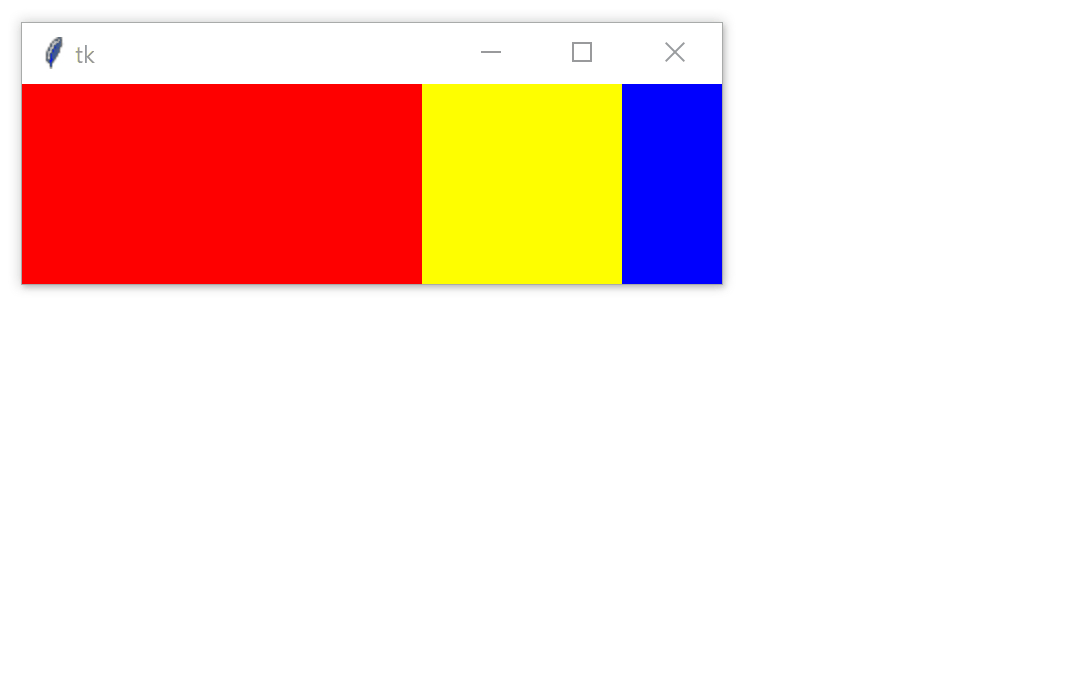
.place()方法
- 精确控制部件的位置
- 需要提供x和y两个参数控制
- 控制的单位为像素,而非字符单位
- 初始的位置(0,0)为窗口或者frame的左上角
import tkinter as tk
window = tk.Tk()
frame = tk.Frame(master=window, width=150, height=150)
frame.pack()
label1 = tk.Label(master=frame, text="I'm at (0, 0)", bg="red")
label1.place(x=0, y=0)
label2 = tk.Label(master=frame, text="I'm at (75, 75)", bg="yellow")
label2.place(x=75, y=75)
window.mainloop()
效果如下:
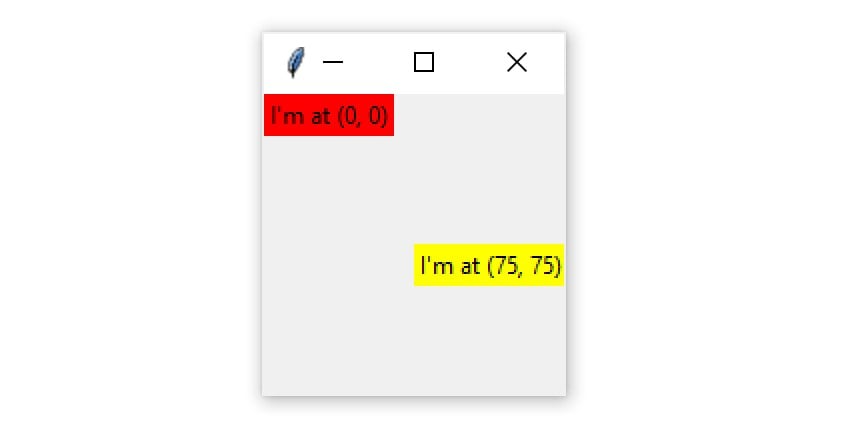
- 两个主要的缺点:
- 布局难管理:Layout can be difficult to manage with
.place(). This is especially true if your application has lots of widgets. - 布局不会随着窗口大小变化而调整:Layouts created with
.place()aren’t responsive. They don’t change as the window is resized..grid()方法
- 布局难管理:Layout can be difficult to manage with
- 将窗口以及框架划分为rows和columns,行列开始的坐标均为1
- 指定部件位置时,需要传入行列坐标
import tkinter as tk
window = tk.Tk()
for i in range(3):
for j in range(3):
frame = tk.Frame(
master=window,
relief=tk.RAISED,
borderwidth=1
)
# Each frame is attached to `window` with the `.grid()` geometry manager:
frame.grid(row=i, column=j)
label = tk.Label(master=frame, text=f"Row {i}\nColumn {j}")
# Each `label` is attached to its master `Frame` with `.pack()`
label.pack()
window.mainloop()
效果如下:

行列之间间距的调整:
1. **`padx`** adds padding in the horizontal direction.
2. **`pady`** adds padding in the vertical direction.
import tkinter as tk
window = tk.Tk()
for i in range(3):
for j in range(3):
frame = tk.Frame(
master=window,
relief=tk.RAISED,
borderwidth=1
)
frame.grid(row=i, column=j, padx=5, pady=5)
label = tk.Label(master=frame, text=f"Row {i}\nColumn {j}")
label.pack()
window.mainloop()
效果如下:

unpack()方法可以用同样的方法调整间距,在此不做赘述。
import tkinter as tk
window = tk.Tk()
for i in range(3):
for j in range(3):
frame = tk.Frame(
master=window,
relief=tk.RAISED,
borderwidth=1
)
frame.grid(row=i, column=j, padx=5, pady=5)
label = tk.Label(master=frame, text=f"Row {i}\nColumn {j}")
label.pack(padx=5, pady=5)
window.mainloop()
让部件的大小随着窗口的调整而调整:
- By using
.columnconfigure()and.rowconfigure()on thewindowobject, you can adjust how the rows and columns of the grid grow as the window is resized. -
.columnconfigure()and.rowconfigure()需要接受三个参数:- Index: The index of the grid column or row that you want to configure or a list of indices to configure multiple rows or columns at the same time
- Weight: A keyword argument called
weightthat determines how the column or row should respond to window resizing, relative to the other columns and rows. 默认为0,即不变化。 - Minimum Size: A keyword argument called
minsizethat sets the minimum size of the row height or column width in pixels
import tkinter as tk
window = tk.Tk()
for i in range(3):
window.columnconfigure(i, weight=1, minsize=75)
window.rowconfigure(i, weight=1, minsize=50)
for j in range(0, 3):
frame = tk.Frame(
master=window,
relief=tk.RAISED,
borderwidth=1
)
frame.grid(row=i, column=j, padx=5, pady=5)
label = tk.Label(master=frame, text=f"Row {i}\nColumn {j}")
label.pack(padx=5, pady=5)
window.mainloop()
窗口设置有最小值是因为需要保证label的字可以被看见。

选择对齐的方式
- 默认所有的部件是居中的, 参考下面两行一列的label ```python import tkinter as tk
window = tk.Tk() window.columnconfigure(0, minsize=250) window.rowconfigure([0, 1], minsize=100)
label1 = tk.Label(text=”A”) label1.grid(row=0, column=0)
label2 = tk.Label(text=”B”) label2.grid(row=1, column=0)
window.mainloop()
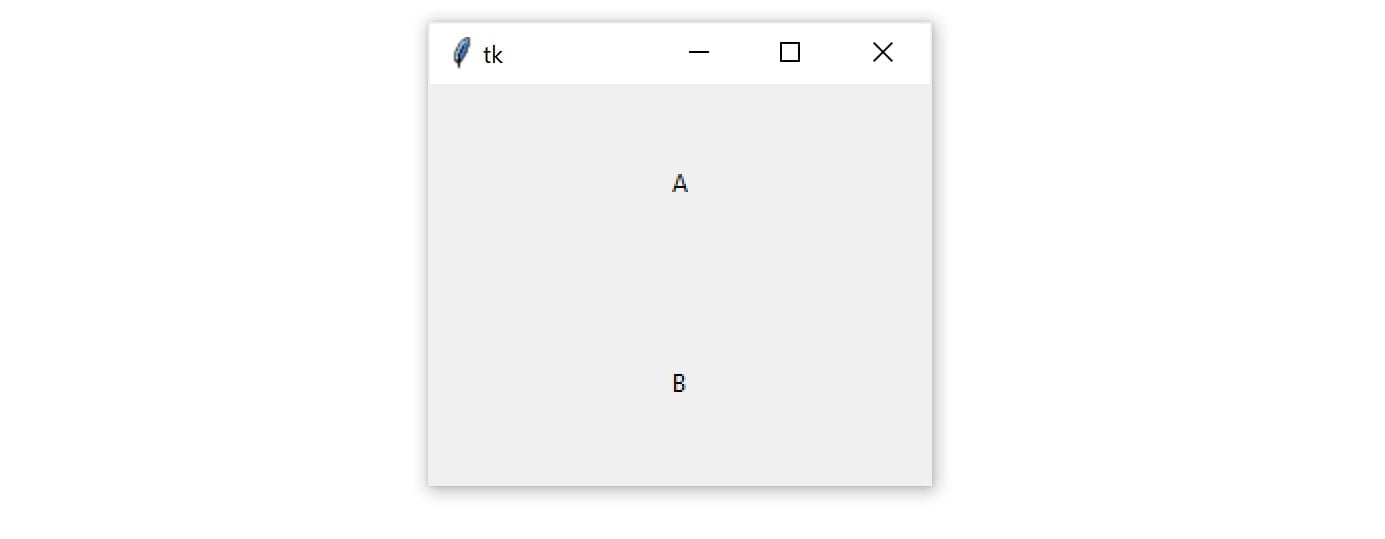
- 可以通过`sticky`参数调整。
- **`"n"` or `"N"`** to align to the top-center part of the cell
- **`"e"` or `"E"`** to align to the right-center side of the cell
- **`"s"` or `"S"`** to align to the bottom-center part of the cell
- **`"w"` or `"W"`** to align to the left-center side of the cell
```python
import tkinter as tk
window = tk.Tk()
window.columnconfigure(0, minsize=250)
window.rowconfigure([0, 1], minsize=100)
label1 = tk.Label(text="A")
label1.grid(row=0, column=0, sticky="ne")
label2 = tk.Label(text="B")
label2.grid(row=1, column=0, sticky="sw")
window.mainloop()

- In order to fill the grid, you can specify
"ns"to force the widget to fill the cell in the vertical direction, or"ew"to fill the cell in the horizontal direction. To fill the entire cell, setstickyto"nsew". The following example illustrates each of these options: ```python import tkinter as tk
window = tk.Tk()
window.rowconfigure(0, minsize=50) window.columnconfigure([0, 1, 2, 3], minsize=50)
label1 = tk.Label(text=”1”, bg=”black”, fg=”white”) label2 = tk.Label(text=”2”, bg=”black”, fg=”white”) label3 = tk.Label(text=”3”, bg=”black”, fg=”white”) label4 = tk.Label(text=”4”, bg=”black”, fg=”white”)
label1.grid(row=0, column=0) label2.grid(row=0, column=1, sticky=”ew”) label3.grid(row=0, column=2, sticky=”ns”) label4.grid(row=0, column=3, sticky=”nsew”)
window.mainloop()

- sticky的填充形式与pack类似:
|`.grid()`|`.pack()`|
|---|---|
|`sticky="ns"`|`fill=tk.Y`|
|`sticky="ew"`|`fill=tk.X`|
|`sticky="nsew"`|`fill=tk.BOTH`|
- <u>grid方法比pack()方法易于理解,且比place()方法复杂,因此应当优先使用。</u>
**Note:** `.grid()` offers much more flexibility than you’ve seen here. For example, you can configure cells to span multiple rows and columns. For more information, check out the [Grid Geometry Manager section](https://tkdocs.com/tutorial/grid.html) of the [TkDocs tutorial](https://tkdocs.com/tutorial/index.html).
# 让应用程序可以交互 Making Your Applications Interactive
- 事件(event):指发生在event loop中的一些会产生一些行为的动作,例如鼠标被按下等等。
- When an event occurs, an event object is emitted, which means that an instance of a class representing the event is created.
- 需要用户写event handler的程序来处理这些事件。
- 调用`window.mainloop()`的时候,就会自动开启事件循环(event loop).
- 事件循环的时候,程序会自动check是否有其他的事件(event)发生。类似于下面伪代码所表现的:
```python
events = []
# Create an event handler
def handle_keypress(event):
"""Print the character associated to the key pressed"""
print(event.char)
while True:
if events == []:
continue
event = events[0]
# If event is a keypress event object
if event.type == "keypress":
# Call the keypress event handler
handle_keypress(event)
bind方法:将event handler和event绑定
- 程序是不知道哪个事件和哪个处理是对应的,所以需要进行绑定
以下代码将<key>事件和handle_keypress绑定在了一起,按下什么,都会在终端回显。
import tkinter as tk
window = tk.Tk()
def handle_keypress(event):
"""Print the character associated to the key pressed"""
print(event.char)
# Bind keypress event to handle_keypress()
window.bind("<Key>", handle_keypress)
window.mainloop()
- bind一般至少需要两个参数:
- An event that’s represented by a string of the form
"<event_name>", whereevent_namecan be any of Tkinter’s events - An event handler that’s the name of the function to be called whenever the event occurs
- An event that’s represented by a string of the form
- bind会被绑定到调用的部件上,换言之:
event_name.bind(Action,"handler_function")
def handle_click(event):
print("The button was clicked!")
button = tk.Button(text="Click me!")
button.bind("<Button-1>", handle_click)
以上代码会窗口被左键的时候,打印相关内容。对于鼠标,常见的操作还有:
"<Button-1>":左键"<Button-2>":中键"<Button-3>":右键
Note: For a list of commonly used events, see the Event types section of the Tkinter 8.5 reference.
运用命令 Using command
- Every
Buttonwidget has acommandattribute that you can assign to a function. Whenever the button is pressed, the function is executed. - 本质就是把事件处理函数当做command传给Button对象
import tkinter as tk
def increase():
value = int(lbl_value["text"])
lbl_value["text"] = f"{value + 1}"
def decrease():
value = int(lbl_value["text"])
lbl_value["text"] = f"{value - 1}"
window = tk.Tk()
window.rowconfigure(0, minsize=50, weight=1)
window.columnconfigure([0, 1, 2], minsize=50, weight=1)
btn_decrease = tk.Button(master=window, text="-", command=decrease)
btn_decrease.grid(row=0, column=0, sticky="nsew")
lbl_value = tk.Label(master=window, text="0")
lbl_value.grid(row=0, column=1)
btn_increase = tk.Button(master=window, text="+", command=increase)
btn_increase.grid(row=0, column=2, sticky="nsew")
window.mainloop()
效果如下:
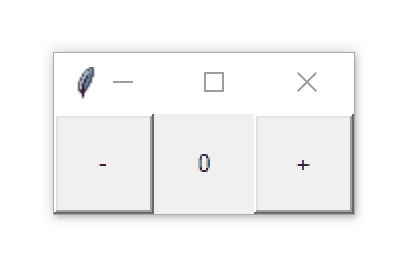
- command后面可以接一个函数列表function_list[],例如:
drop_btn = tk.Button(frm_buttons,text="Drop",bg="blue",fg="yellow",command=lambda: [animation(gif_lbl,drop_page_w,current_frame=0), drop_name(name_lbl)])
华摄氏度和摄氏度转换
import tkinter as tk
def fahrenheit_to_celsius():
"""Convert the value for Fahrenheit to Celsius and insert the
result into lbl_result.
"""
fahrenheit = ent_temperature.get()
celsius = (5 / 9) * (float(fahrenheit) - 32)
lbl_result["text"] = f"{round(celsius, 2)} \N{DEGREE CELSIUS}"
# Set up the window
window = tk.Tk()
window.title("Temperature Converter")
window.resizable(width=False, height=False)
# Create the Fahrenheit entry frame with an Entry
# widget and label in it
frm_entry = tk.Frame(master=window)
ent_temperature = tk.Entry(master=frm_entry, width=10)
lbl_temp = tk.Label(master=frm_entry, text="\N{DEGREE FAHRENHEIT}")
# Layout the temperature Entry and Label in frm_entry
# using the .grid() geometry manager
ent_temperature.grid(row=0, column=0, sticky="e")
lbl_temp.grid(row=0, column=1, sticky="w")
# Create the conversion Button and result display Label
btn_convert = tk.Button(
master=window,
text="\N{RIGHTWARDS BLACK ARROW}",
command=fahrenheit_to_celsius
)
lbl_result = tk.Label(master=window, text="\N{DEGREE CELSIUS}")
# Set up the layout using the .grid() geometry manager
frm_entry.grid(row=0, column=0, padx=10)
btn_convert.grid(row=0, column=1, pady=10)
lbl_result.grid(row=0, column=2, padx=10)
# Run the application
window.mainloop()

写一个文本编辑器
import tkinter as tk
from tkinter.filedialog import askopenfilename, asksaveasfilename
def open_file():
"""Open a file for editing."""
filepath = askopenfilename(
filetypes=[("Text Files", "*.txt"), ("All Files", "*.*")]
)
if not filepath:
return
txt_edit.delete("1.0", tk.END)
with open(filepath, mode="r", encoding="utf-8") as input_file:
text = input_file.read()
txt_edit.insert(tk.END, text)
window.title(f"Simple Text Editor - {filepath}")
def save_file():
"""Save the current file as a new file."""
filepath = asksaveasfilename(
defaultextension=".txt",
filetypes=[("Text Files", "*.txt"), ("All Files", "*.*")],
)
if not filepath:
return
with open(filepath, mode="w", encoding="utf-8") as output_file:
text = txt_edit.get("1.0", tk.END)
output_file.write(text)
window.title(f"Simple Text Editor - {filepath}")
window = tk.Tk()
window.title("Simple Text Editor")
window.rowconfigure(0, minsize=800, weight=1)
window.columnconfigure(1, minsize=800, weight=1)
txt_edit = tk.Text(window)
frm_buttons = tk.Frame(window, relief=tk.RAISED, bd=2)
btn_open = tk.Button(frm_buttons, text="Open", command=open_file)
btn_save = tk.Button(frm_buttons, text="Save As...", command=save_file)
btn_open.grid(row=0, column=0, sticky="ew", padx=5, pady=5)
btn_save.grid(row=1, column=0, sticky="ew", padx=5)
frm_buttons.grid(row=0, column=0, sticky="ns")
txt_edit.grid(row=0, column=1, sticky="nsew")
window.mainloop()
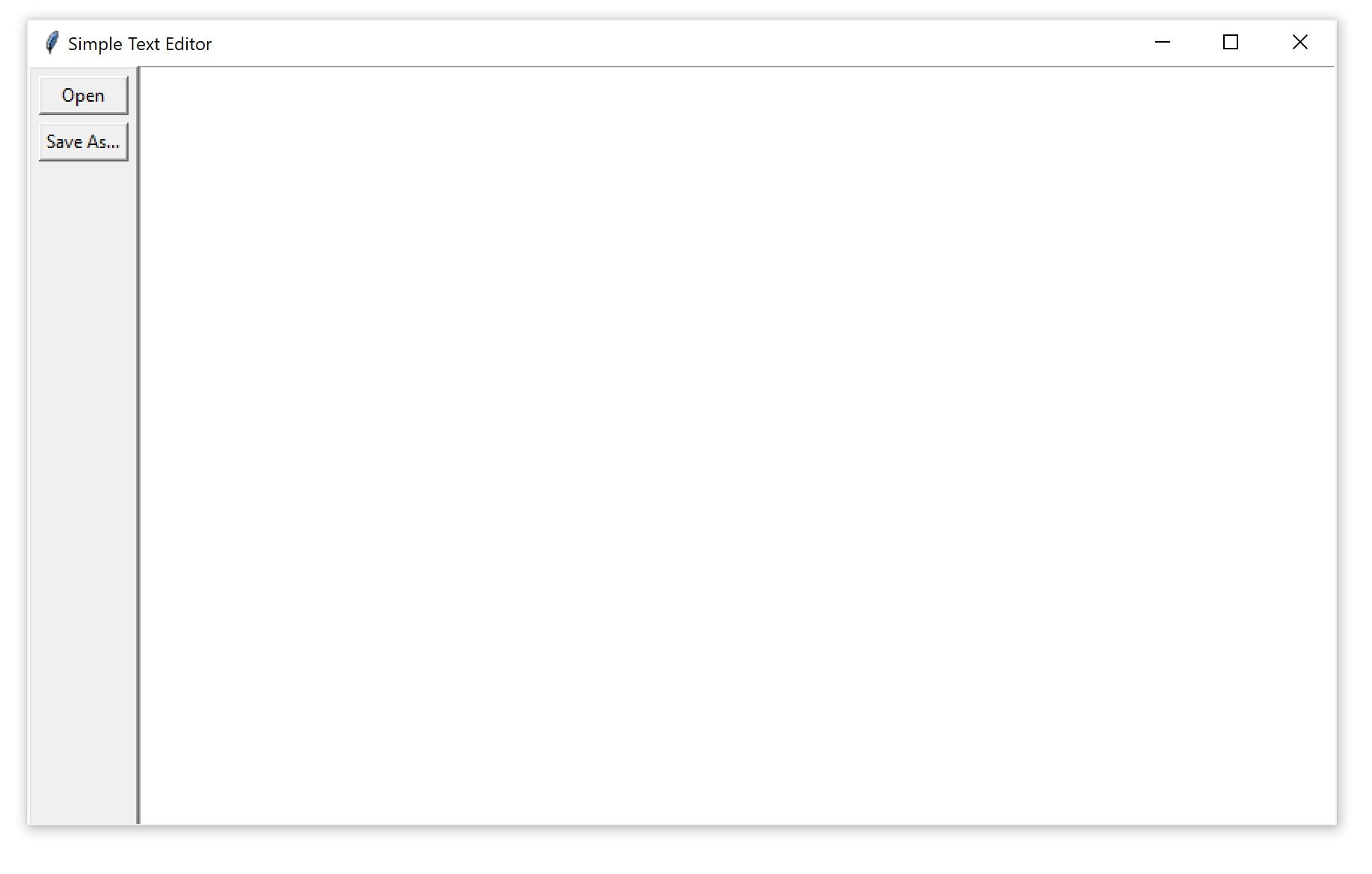
如何用Tkinter显示Gif
参考:Displaying Gifs in Tkinter - Python
- gif: a collection of frames(images) that are shown in a sequence, in a loop, thus creating an animation effect.
s1 Import required packages
import tkinter as tk
from PIL import Image
s2 Create the main application window and run the event loop
root = tk.Tk()
root.title("Displaing Gif")
root.mainloop()
s3 Add labels and buttons
In gif_label gif will be displayed. And we have a start and stop button to control the gif.
gif_label = tk.Label(root, image="")
gif_label.pack()
start = tk.Button(root, text="Start", command = lambda: animation(current_frame = 0))
start.pack()
stop = tk.Button(root, text="Stop", commnad = stop_animation)
stop.pack()
S4 Store Gif’s path in the variable and open it using the pillow module.
- Get the number of frames in the Gif and then create photoimage object for each frame and store them in a list.
formatparameter in the photoimage class is required to read the frames of the gif. ```python file = “gif_file.gif” info = Image.open(file) frames = info.n_frames # number of frames
photoimage_objects = [] for i in range(frames): obj = tk.PhotoImage(file = file, format = f”gif -index {i}”) photoimage_objects.append(obj)
## S5 Create functions: animation and stop_animation to start and stop the gif respectively
```python
def animation(current_frame=0):
global loop
image = photoimage_objects[current_frame]
gif_label.configure(image = image)
current_frame = current_frame + 1
if current_frame == frames:
current_frame = 0 # reset the current_frame to 0 when end is reached
loop = root.after(50, lambda: animation(current_frame))
The above animation function takes current_frame as an argument, which indicates the frame number that is going to be displayed.
So to display gif we have to start showing frames from the 0th index.
And to continuously update the frame we have to keep calling the function in a loop so we used root.after() which calls the function after every 50ms
S6 Create stop_animation function
def stop_animation():
root.after_cancel(loop)
root.after_cancel(loop) cancels the scheduled function which has an after_id = loop.
That’s why we declared loop = None, outside the function so that it can be used in both start and stop_animation.
以下为完整代码:
import tkinter as tk
from PIL import Image
root = tk.Tk()
root.title("Displaing Gif")
file = "gif_file.gif"
info = Image.open(file)
frames = info.n_frames # number of frames
photoimage_objects = []
for i in range(frames):
obj = tk.PhotoImage(file=file, format=f"gif -index {i}")
photoimage_objects.append(obj)
def animation(current_frame=0):
global loop
image = photoimage_objects[current_frame]
gif_label.configure(image=image)
current_frame = current_frame + 1
if current_frame == frames:
current_frame = 0
loop = root.after(50, lambda: animation(current_frame))
def stop_animation():
root.after_cancel(loop)
gif_label = tk.Label(root, image="")
gif_label.pack()
start = tk.Button(root, text="Start", command=lambda: animation(current_frame=0))
start.pack()
stop = tk.Button(root, text="Stop", command=stop_animation)
stop.pack()
root.mainloop()
Tkinter References
Here are some official resources to check out:
- The official Python Tkinter reference documentation covers Python’s Tkinter module in moderate depth. It’s written for more advanced Python developers and isn’t the best resource for beginners.
- Tkinter 8.5 reference: a GUI for Python is an extensive reference covering the majority of the Tkinter module. It’s exhaustive, but it’s written in the reference style without commentary or examples.
- The Tk Commands reference is the definitive guide to commands in the Tk library. It’s written for the Tcl language, but it answers a lot of questions about why things work the way they do in Tkinter.
 安然的小木屋
安然的小木屋